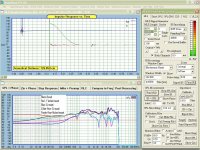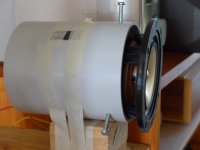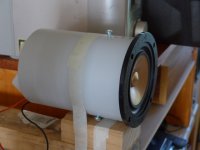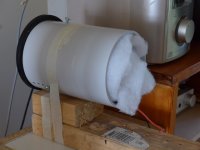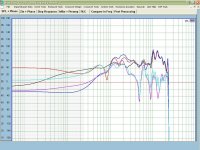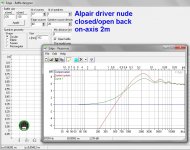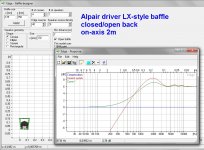They're not directly interchangeable I'm afraid. Attempting to load a 2x4 setup file to a 2x8 unit (or vice versa) will not work and will hose up the configuration on the host computer requiring a software reset.
However, SL has posted an LXmini configuration file for the miniDSP 4x10Hd unit, which can be used (with a little modification) on the other miniDSP 2x8 units.
Proper configuration and making sure the xover/EQ settings are duplicated are obviously critical if cross-platforming. We will certainly be providing the necessary information in the Resources area of the OUG.
Dave.
However, SL has posted an LXmini configuration file for the miniDSP 4x10Hd unit, which can be used (with a little modification) on the other miniDSP 2x8 units.
Proper configuration and making sure the xover/EQ settings are duplicated are obviously critical if cross-platforming. We will certainly be providing the necessary information in the Resources area of the OUG.
Dave.
I ve been using minidsp 2x4 together with minidigi for almost 4 years now.
I have no issues with noise and no complaints with the internal dacs.
The broblem I had was the low output 0.9V which was not sufficient to drive my gainclone amps. I had to change the amps gain to 32 and beside that I added an opamp buffer between the dsp and the amps. This gave me more slam and speed at low end. Without the buffers the amp is on the slow side.
You will also have to use a 4gang analog volume pot, because the digital volume pot is loosing resolution.
I have never use the analog inputs, so I cant comment about the Adc function.
I have no issues with noise and no complaints with the internal dacs.
The broblem I had was the low output 0.9V which was not sufficient to drive my gainclone amps. I had to change the amps gain to 32 and beside that I added an opamp buffer between the dsp and the amps. This gave me more slam and speed at low end. Without the buffers the amp is on the slow side.
You will also have to use a 4gang analog volume pot, because the digital volume pot is loosing resolution.
I have never use the analog inputs, so I cant comment about the Adc function.
I would appreciate someone else checking but I believe the 2x8 has higher output.
That might be the most straight-forward approach for amps that require it. If so it will be great to get the 2x8 configuration file.
It's a circuit board, and $300 instead of $90 for the 2x4 board
but has balanced inputs and outputs, higher input and output capabilities for low gain amps like the Pass designs,
The internal processing rate is 96 kHz (up from 48 kHz in the 2x4)
can drive the LX mini plus 2 subs plus 2 more somethings (or maybe 2 sets of LX mini's?, or maybe if you make the big LX someday)
So all and all it seems like good value.
There is no boxed version but for $500 there is the 4x10hd which seems very very similar in specs and also has 8 analog, (there seem to be 2 digital outputs to make the "10", maybe other stuff)
So there is a real savings getting the board if you have, or don't need a cool box
That might be the most straight-forward approach for amps that require it. If so it will be great to get the 2x8 configuration file.
It's a circuit board, and $300 instead of $90 for the 2x4 board
but has balanced inputs and outputs, higher input and output capabilities for low gain amps like the Pass designs,
The internal processing rate is 96 kHz (up from 48 kHz in the 2x4)
can drive the LX mini plus 2 subs plus 2 more somethings (or maybe 2 sets of LX mini's?, or maybe if you make the big LX someday)
So all and all it seems like good value.
There is no boxed version but for $500 there is the 4x10hd which seems very very similar in specs and also has 8 analog, (there seem to be 2 digital outputs to make the "10", maybe other stuff)
So there is a real savings getting the board if you have, or don't need a cool box
Last edited:
It does.
The 2x8 unit has a switchable output gain that provides 1.3VRMS or 2.5VRMS at 0dbFS. This provides an increase above the 2x4 unit of 3.2db and 8.9db respectively. So, you'd have an increased compatibility with amplifiers of lower than nominal voltage gain.
The 4x10Hd file I mentioned is the same as a 2x8 configuration file. (There is some somewhat confusing labeling in the miniDSP hardware/software line.) 🙂
Dave.
The 2x8 unit has a switchable output gain that provides 1.3VRMS or 2.5VRMS at 0dbFS. This provides an increase above the 2x4 unit of 3.2db and 8.9db respectively. So, you'd have an increased compatibility with amplifiers of lower than nominal voltage gain.
The 4x10Hd file I mentioned is the same as a 2x8 configuration file. (There is some somewhat confusing labeling in the miniDSP hardware/software line.) 🙂
Dave.
I may be completely wrong but the 2x8 board seems to be very similar to the 4x10 box.
so it isn't surprising that the configuration files are the same, and the output higher for both. But for me, very good news, meaning that I can order the 2x8 right now and have it work (right? )
so it isn't surprising that the configuration files are the same, and the output higher for both. But for me, very good news, meaning that I can order the 2x8 right now and have it work (right? )
Last edited:
Yes, the 4x10Hd "in the box" unit is simply the standard 2x8 mainboard with the addition of the DIGI-FP (digital input/output) and VOL-FP (volume/input selection) boards, and all installed in the nice 1U rack chassis enclosure.
Dave.
Dave.
I may be completely wrong but the 2x8 board seems to be very similar to the 2x10 box.
so it isn't surprising that the configuration files are the same, and the output higher for both. But for me, very good news, meaning that I can order the 2x8 right now and have it work (right? )
The 2x8 is a populated PCB (no onboard PS) with 2 analog input channels and 8 analog output channels.
The 4x10 Hd is a ready-to-use, 2-analog/2-spdif input, 8-analog/2-spdif output unit in a case and including power supply. I/O can be balanced or unbalanced. It also has onboard selection of inputs, a good digital volume control, and the ability to switch between four "programs" (different DSP configurations) using the front panel knob. Inside the 4x10 case is the 2x8 board, and some other boards to expand the functionality. That is why the configuration file can be used with both.
Its up to you to decide which is right for your needs, but I would suggest springing for the 4x10.
Edit: Ah, Davey beat me to the reply! Posted while I typed.
I agree, the 4x10 is very good value, those guys have figured out their marketing to tempt you! The choice is $100, 300, or 500 and each has its temptations..and each is a fine choice really.
For the quality and that it's easy to return if it doesn't work (no one could claim that you'd fried it assembling it) and plug and play w/ PSU etc, it's logical to pay for the 4x10, and you get a lot extra actually...
OTOH: $100, $300, $500 are very different price points
For the quality and that it's easy to return if it doesn't work (no one could claim that you'd fried it assembling it) and plug and play w/ PSU etc, it's logical to pay for the 4x10, and you get a lot extra actually...
OTOH: $100, $300, $500 are very different price points
Last edited:
I agree, the 4x10 is very good value, those guys have figured out their marketing to tempt you! The choice is $100, 300, or 500 and each has its temptations..and each is a fine choice really.
For the quality and that it's easy to return if it doesn't work (no one could claim that you'd fried it assembling it) and plug and play w/ PSU etc, it's logical to pay for the 4x10, and you get a lot extra actually...
OTOH: $100, $300, $500 are very different price points
Right, and there is the application to consider. The 2x4 would be fine for a pair of 2-way speakers. It's also what I am using in my latest active loudspeaker project, where a crossover is built into each speaker. It wouldn't make sense to use a 2x8 in that capacity, since I could not make use of 8 output channels.
I own a 4x10Hd and it's very easy to use and works well.
I would go with the 4x10HD in any case. You have more portions, higher output, high sampling rate and it's just better than the 2x4.
For a DIYer I totally agree..my time is worth something, and the 4x10 solves lots of issues. .
Last edited:
The displacement of the acoustic centre may be frequency dependant, and may vary with box dimensions so there is unlikely to be a figure that applies to any particular driver.
Keith
Just trying to get a handle on the reason for the placement of the FR driver. I wonder if TA results obtained by measuring the distance to the listener of each driver from its center at its mounting flange plane differ from those obtained with a mic?
Dan
Just trying to get a handle on the reason for the placement of the FR driver. I wonder if TA results obtained by measuring the distance to the listener of each driver from its center at its mounting flange plane differ from those obtained with a mic?
Dan
SL has answered you question on the other forum, has he not?
His objective was to approximately line-up the dipole null of the FR driver over the center of the woofer. Obviously there is some modification of the woofer radiation pattern with the physical placement of the tweeter driver/structure, but he evaluated/optimized this empirically. The DSP is then used to time-align the result based on measurements with the microphone on the design axis.
Dave.
The physical and acoustical centers are not the same for cones and obvious ly also F-dependent. Pluto's tweeter is positioned differently from LXmini by the way.
The physical and acoustical centers are not the same for cones and obvious ly also F-dependent. Pluto's tweeter is positioned differently from LXmini by the way.
Yeah, but that's not what I said. 🙂 And I don't know what the Pluto system has to do with this. Obviously, that's a different system.
For the LXmini, the acoustic center, the filtering action of the crossover, and some other factors contribute.
It seems he's optimized the placement of the tweeter driver considering many factors and then fine-tuned the integrated result using the pure-delay capability of the miniDSP platform. It's an even order acoustic crossover and a reverse polarity connection to one of the drivers should yield a nice interference null. That's how the delay setting of this system was optimized.
Cheers,
Dave.
SL has answered you question on the other forum, has he not?
Dave.
I'm looking for it duh.
Yeah, but that's not what I said. 🙂 And I don't know what the Pluto system has to do with this. Obviously, that's a different system.
For the LXmini, the acoustic center, the filtering action of the crossover, and some other factors contribute.
It seems he's optimized the placement of the tweeter driver considering many factors and then fine-tuned the integrated result using the pure-delay capability of the miniDSP platform. It's an even order acoustic crossover and a reverse polarity connection to one of the drivers should yield a nice interference null. That's how the delay setting of this system was optimized.
Cheers,
Dave.
The front pattern of the tweeter is affected by placement. Actually I was wondering if that's one of the reasons he placed the Pluto tweeter up front...but then gave up on the idea in the mini.
LXMini Driver tests
Hi,
I did some tests on the MarkAudio driver, CHR-70III operating as LXMini
OB. It seems to work quite well considering it costs about $35 each and
with 86dB sensitivity. All tests were taken with NO equalization.
Enclosed here are 5 tests(gated at 4mS), each tests is named as follows:
Boxed, driver mounted in a sealed box
Flushed mount, as shown on image
SL mount, as shown image similar to mount from LXMini
Rear SL mount, rear Freq. resp., driver mount similar to LXMini
Rear Flushed mount, rear Freq. resp., driver is flushed mount.
Note that there is a resonance around 6kHz(see rear response), this is
not really caused by the resonance between the tube and driver, this
resonance is a function of the driver, see the kink around the same
frequency around the the same freq., 6kHz when driver is boxed.
Hi,
I did some tests on the MarkAudio driver, CHR-70III operating as LXMini
OB. It seems to work quite well considering it costs about $35 each and
with 86dB sensitivity. All tests were taken with NO equalization.
Enclosed here are 5 tests(gated at 4mS), each tests is named as follows:
Boxed, driver mounted in a sealed box
Flushed mount, as shown on image
SL mount, as shown image similar to mount from LXMini
Rear SL mount, rear Freq. resp., driver mount similar to LXMini
Rear Flushed mount, rear Freq. resp., driver is flushed mount.
Note that there is a resonance around 6kHz(see rear response), this is
not really caused by the resonance between the tube and driver, this
resonance is a function of the driver, see the kink around the same
frequency around the the same freq., 6kHz when driver is boxed.
Attachments
This Alpair flange (baffle for dipole) is 5" (125mm) radiating membrane is 4" (102mm)
Here is a Edge sim of it open and closed back. We can see what round "baffle does to treble response. For comparison the datasheet response in large flat and angular baffle sort of LX521 style
Here is a Edge sim of it open and closed back. We can see what round "baffle does to treble response. For comparison the datasheet response in large flat and angular baffle sort of LX521 style
Attachments
- Status
- Not open for further replies.
- Home
- Loudspeakers
- Multi-Way
- New Linkwitz "LXmini" speakers
